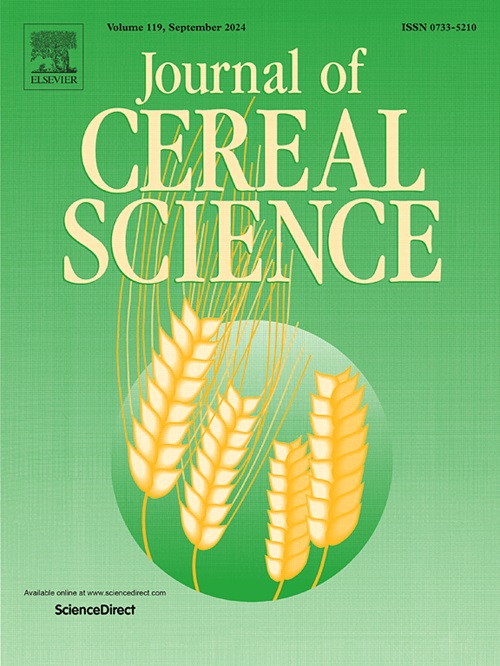Impact of atmospheric pressure cold plasma on the physicochemical, rheological, chemical functional groups via FTIR spectroscopy and antioxidant characteristics of sunn pest (Eurygaster integriceps)-damaged wheat flour
IF 3.9
2区 农林科学
Q2 FOOD SCIENCE & TECHNOLOGY
引用次数: 0
Abstract
Achieving the desired quality product characteristics with Sunn pest (Eurygaster integriceps) damaged wheat flour (SDWF) is still a major challenge. Cold plasma technology (CPT) is a promising innovative alternative to improve the technological qualities of SDWF. This study is aimed to determine the effect of CPT on physicochemical, rheological, chemical functional groups (OH, N-H, C = O, C-O-C, C-O and C-O-H) by using Fourier Transform Infrared Spectroscopy (FTIR) and antioxidant properties of SDWF. SDWF was subjected to CPT for various exposure times (0, 30, 45, and 60 s). CPT-treated SDWF showed a significant increase in gluten index values regardless of the exposure time. Moreover, the CPT significantly enhanced the delayed sedimentation, with a 45s exposure time demonstrating the greatest improvement. Falling numbers of SDWF approached standard values with 45 and 60 s CPT. The Kieffer dough extensibilities were significantly impacted by both CPT and its varying exposure times. CPT reduced the SMS/Chen-Hoseney dough stickiness, a significant issue in SDWF. FTIR analysis revealed an increase in OH concentration at all CPT times, and an increase in α-helix structure and β-layer at 30 and 45 s treatment times. When CPT was administered for longer than 30 s, both bond and free phenolic content of SDWF decreased. Based on our results, we can strongly suggest that CPT could be used to improve the technological properties of SDWF, even for short exposure times such as 30 and 45 s; thus, this innovative technology has the potential to improve the bread-making quality of these flours.

大气压冷等离子体对日晒害小麦粉理化、流变学、化学官能团及抗氧化特性的影响
利用日晒害虫(Eurygaster integriceps)受损小麦粉(SDWF)实现理想的优质产品特性仍然是一个重大挑战。冷等离子体技术(CPT)是一种很有前途的创新选择,可以提高SDWF的技术质量。本研究旨在通过傅里叶变换红外光谱(FTIR)测定CPT对SDWF的理化、流变、化学官能团(OH、N-H、C = O、C-O-C、C-O和C-O- h)的影响以及抗氧化性能。在不同的暴露时间(0、30、45和60 s)下,经CPT处理的SDWF的谷蛋白指数值显著增加,与暴露时间无关。此外,CPT显著增强了延迟沉积,以45s的暴露时间改善最大。在45和60秒CPT时,SDWF数量下降,接近标准值。基弗面团的延伸性受到CPT及其不同暴露时间的显著影响。CPT降低了SMS/Chen-Hoseney面团的粘性,这是SDWF的一个重要问题。FTIR分析显示,在所有CPT时间OH浓度均增加,α-螺旋结构和β-层在处理时间30和45 s时增加。当CPT作用时间超过30 s时,SDWF的键和游离酚含量均下降。基于我们的研究结果,我们强烈建议CPT可以用于改善SDWF的工艺性能,即使是在短曝光时间(如30和45 s);因此,这项创新技术有可能提高这些面粉的面包制作质量。
本文章由计算机程序翻译,如有差异,请以英文原文为准。
求助全文
约1分钟内获得全文
求助全文
来源期刊

Journal of Cereal Science
工程技术-食品科技
CiteScore
7.80
自引率
2.60%
发文量
163
审稿时长
38 days
期刊介绍:
The Journal of Cereal Science was established in 1983 to provide an International forum for the publication of original research papers of high standing covering all aspects of cereal science related to the functional and nutritional quality of cereal grains (true cereals - members of the Poaceae family and starchy pseudocereals - members of the Amaranthaceae, Chenopodiaceae and Polygonaceae families) and their products, in relation to the cereals used. The journal also publishes concise and critical review articles appraising the status and future directions of specific areas of cereal science and short communications that present news of important advances in research. The journal aims at topicality and at providing comprehensive coverage of progress in the field.
 求助内容:
求助内容: 应助结果提醒方式:
应助结果提醒方式:


